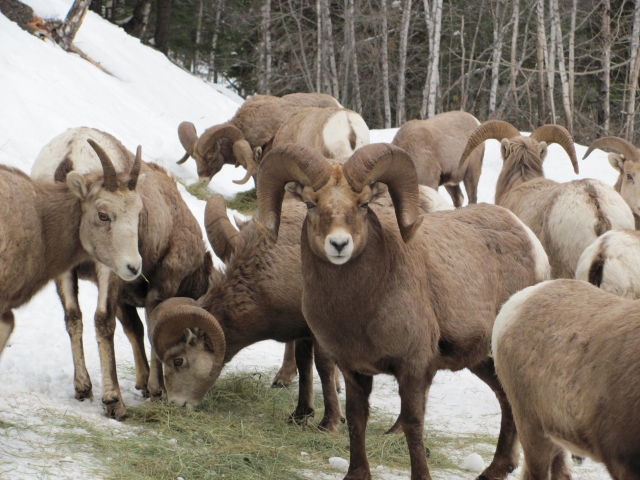Out There: No stalking here, just big horn sheep chillin’ for the camera
For me, the best thing about living here in the Kootenays is the wildlife. I love wildlife, I love taking pictures of wildlife, and I love sharing those pictures with my friends from all over the world who are wowed by our wildlife here. I have been known to walk around neighbourhoods after sighting a bear so I can take that ultimate wildlife shot. I’ve only had a couple epic bear shots because those animals are so elusive exactly at the time you don’t want them to be: when you have your camera in hand!
I have some great shots of other wildlife, but animals are notoriously difficult to pose; they don’t stand still, they don’t co-operate, and sometimes they are just plain not interested. It’s very frustrating! But, luckily, I had the opportunity to take some amazing wildlife shots last weekend–with a new camera I got with a 10x zoom!–at a place where the subject matter was a tad more co-operative than normal. This happened along the Salmo-Creston highway, more towards the Salmo end of the pass, where a herd of big horn sheep spend the winter, and where this herd are fed three times a week by volunteers in a joint program between theTrail Wildlife Association (TWA) and the Nelson Rod & Gun Club (NRGC).
This program was started about twenty years ago by the Creston gun club, but as it was a long way for the East Kootenay volunteers to travel, the torch was passed to the NRGC because it had members living in Salmo. Now, volunteers from the TWA come once a week with a week’s worth of alfalfa pellets, and twice a week volunteers the NRGC come with hay. They use two tons of hay a year on this project, which goes for about $175 a ton, but this year the hay was donated by Salmo residents Rick and Sue Bundschuh.
You may be thinking, ‘wait a sec, isn’t it illegal to feed wildlife?’ Well, it is–normally. But in this case, it’s not a problem. The Fish & Wildlife branch of the Ministry of Environment has given the group permission to feed this herd because the feeding serves a very important purpose: it keeps these sheep off the highway, where they would normally gather in order to lick the salt off the road. This created a danger for the animals and for vehicles travelling a high speeds between Salmo and Creston. Along with hay and afalfa, the herd also has at their feeding spot a salt lick, which was provided by NRGC members.
Conservation is a large part of the NRGC’s mandate, and Bob Vliet, a NRGC member, stresses that the point of conserving these rams, ewes, and lambs is not so other members of the club can go out and hunt them. “They are still a limited entry hunt,” Mr. Vliet explained to me at the feeding on Saturday, as a surprisingly placid, though slightly skittish, bunch of sheep munched on hay and alfalfa a mere four feet away. “You can’t just buy a hunting license and go out and hunt them. There was only one permit put out this year and only one was taken. Other years they put out lots of permits and none are taken. One year there were 10 permits put out and only one was taken.” Mr. Vliet went on to explain that these animals are not easy to hunt because when they are up higher and in their summer environment, they can be quite elusive.
The story of this particular herd is quite interesting. Their ancestors were from a herd in the Banff/Jasper area, but they were moved to the States. The group of sheep that come to this feeding location are the scions of that herd, who have since migrated around the area on the Canadian side. The whole herd, however, is about twice the size of this group, which numbers around the three dozen mark. Vliet told me that after mating season, at around the beginning of December, the herd, which summers in the alpine meadows and mountains on the Canadian side – around Ripple Mountain, Stag Leap, Dominion, the Three Sisters, Nevada, Wolf Mountain, etc. – starts to break up, and about half the sheep stay here at this particular spot while the rest migrate south to the Sullivan Lake area. “It’s not always the same ones, but nearly the same number, that come this way, and the rest of them head down that way,” says Vliet, who notes that the numbers of this group could be bigger than the 36 they know of because it’s possible that not everyone shows up for lunch.
Vliet says the feeding program has been highly successful, remarking that only one sheep, a ewe, was the victim of a vehicular fatality this season, back in the fall. “If we didn’t have this salt out right now, there would be 15 of them standing along the road, and if you have one of those chip trucks coming down here at 45mph, they couldn’t possibly stop.”
In addition to the to these big horn sheep, there is a small herd of nine mule deer that eat the food put out by this program, though they are much shyer and they weren’t around when we were there. Also, the alfalfa feeding trough is home to one huge, obese, but very friendly and content white footed deer mouse, who loved all the attention. This was one wild animal who was not afraid to be photographed! In fact, he was all over it when I picked him up and petted him. He was hilariously huge for a tiny creature, so rotund from a constant food source that he could barely walk; instead, he waddled around on what seemed like little sticks, oblivious to the comparatively gigantic sheep who were stomping all around him.
On Saturday, there were 33 big horn sheep in attendance. They came in two groups and all were in very good condition, except one ewe who had an injured foot. Also in attendance was a First Nations group from the Nelson area who had come to see the sheep. The NRGC welcomes groups during feeding times, which occur Monday, Wednesday, and Saturdays, with TWA doing the feeding on Wednesdays, at 10 AM. Dan Danforth, a NRGC volunteer at Saturday’s feeding, told me that they have had many groups come along to observe the sheep, including school groups, Selkirk college students, families and local residents.
“This is one of the few places out there where you can come off the highway and see big horn sheep in their natural winter range,” Danforth said. “And it’s one of the only places we’re aware of where the public is welcome to observe and photograph [the animals in their natural habitat].” But it does come with a rule: no feeding of the sheep is allowed, and there is no interaction allowed. “It’s not a petting zoo!” Danforth emphasizes.
Well, I petted the mouse, but that doesn’t count. I also got some amazing shots of rams with their majestic, C-shaped horns, ewes with their small, straighter horns, and little lambs, who were probably only about 6 – 7 months old. They were fascinating to watch, and as they were quite focused on filling up, they didn’t mind at all posing for some photos. I didn’t have to do any chasing around. What a treat!
For more information on the big horn sheep project along the Salmo-Creston, you can visit the NRGC’s site.


























